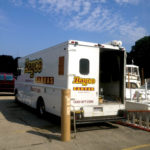Taking the show on the road
Mobile shops are an increasingly popular option for onsite repairs.
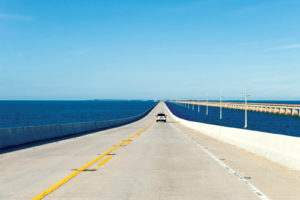 In today’s fast-paced world, what could be better than having your marine fabrication projects done on site? These modular, mobile structures are an excellent solution for a world that craves quick, convenient service but is still unwilling to give up on the exceptional craftsmanship that marine fabricators provide. Not only do mobile fabrication units meet the demands of the customers, but they also offer many advantages for the business owner and operator who are looking for new ways to expand their business.
In today’s fast-paced world, what could be better than having your marine fabrication projects done on site? These modular, mobile structures are an excellent solution for a world that craves quick, convenient service but is still unwilling to give up on the exceptional craftsmanship that marine fabricators provide. Not only do mobile fabrication units meet the demands of the customers, but they also offer many advantages for the business owner and operator who are looking for new ways to expand their business.
A growing niche
Nowhere is the proverbial real estate mantra “location, location, location” more apropos than in the marine fabrication environment. During this time of economic recovery, one of the problems facing many marine fabrication businesses is evaluating whether to expand their clientele base by “going mobile.” Mobile marine fabrication shops can represent a booming subcategory, to be sure. With well-defined signage on mobile units, having your expertise onsite at a marine location can draw prospective customers into the fold, while offering new avenues of revenue.
For many marine fabricators, working onsite is often dependent on the size of the vessels on which they are working and the climate in which they find themselves. Fabricators who have short seasons might find more work if they are able to service boats onsite,
as well as in-house.
Most marine fabricators have to work when the weather is nice, or plan their inside work accordingly. According to Charlie Kees, owner of Mister Sew-N-Sew Custom Canvas in Halfmoon, N.Y., that is actually the first rule of mobile workshop: Be mindful of the weather.
“Thunder and lightning storms are serious business and you do not want to be on or near the water in a storm,” Kees says. “I always watch the weather and plan to be in my nice, dry shop on rainy days.”
Mister Sew-N-Sew Custom Canvas is a semi-mobile marine fabricating company. Kees, along with his wife, Marcia, own the shop, which is located one mile from the Mohawk River and New York’s Erie Canal. There are several other water bodies within a short drive from their shop, including the Hudson River, Lake George, Lake Champlain, the Great Sacandaga Lake, and Saratoga Lake—providing ample opportunity for onsite work. Depending on the nature and location of the job, they provide both in-house and on-site work.
So how does Kees decide if he needs to “go mobile”? Quite simply, if the customer’s boat can be trailered, they prefer to have it brought to their shop. Otherwise for larger vessels, Kees works onsite at the customer’s locale.
“All of my equipment is in my shop, and I can usually complete a job more quickly if the boat is brought to our shop by the customer,” Kees says. “I can also do work in my shop year-round while the weather outside is not particularly agreeable. I do not tow the boats on the highway; our customer needs to bring it to us.”
For larger boats, however, there is a definite need to travel to the boat—albeit in storage or on the water. Normally, after Kees has spoken to the customer to learn what they want and get permission to be on their boat, he goes to the boat, takes measurements, creates patterns, and takes notes. “I go back to the shop to prepare the job, whether it is a new frame, canvas, replacement windows, etc.,” Kees says. “Then I go back to the boat and install the job. If it is a large job, this may take several trips. There is travel time, but for us, this is manageable.”
Kees’ rule of thumb for travel to a job is about 50 miles, one-way. “We do not have a travel trailer to perform sewing onsite,” Kees says. “We have a pickup truck, and I take whatever tools and equipment I need with me for the particular job I am working on.”
Kees’ travel time is offset by not having to buy a trailer, equip it, provide insurance, state inspections, and pay extra gas to tow a trailer. “Also, you need to have permission to set up a trailer somewhere and some places may not allow this, and/or you may need a permit of some type,” Kees says. “I am also concerned about security for my equipment when I am not on site.”
Making it work
-
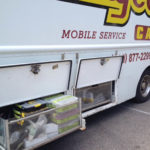
- Carol and Darrell Turner of Rayco Canvas in Hartville, Ohio, have been mobile for years. Their truck, above and below, is a model of mobile efficiency.
-
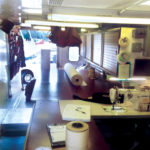
- The size of mobile units is critical as it can limit just where fabricators can set up their mobile shop.
-
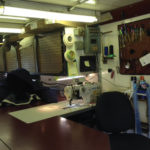
- The Turner’s mobile shop is equipped with a generator to run electrical machinery in case a local marina cannot provide power.
-
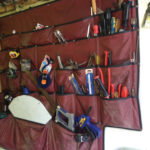
- The immediately accessible Rayco tool selection allows the Turners to provide a variety of onsite fabrication services, including bending frames and fabricating complete enclosures.
Industry experts agree that a mobile unit is great for shops that are near large lakes or the ocean, with large boats that cannot be trailered to a shop.
Rayco Canvas in Hartville, Ohio, has been mobile for several years. Owner Carol Turner and her husband, Darrell, have learned a tremendous amount about what makes a mobile marine fabricator unit a viable entity.
“You have to be totally self-contained and you have to have a generator because electric is not always available at the job site,” Turner says. “You can use a truck or trailer, but you have to utilize all the space you have available. It involves a lot of thought on what jobs you do most and what your needs are for them.”
Turner advises fabricators to consider the size of their mobile unit as some marinas don’t have much space, and if you have too large of a unit, it limits where you can go.
“You start with the basic things you need in the truck or trailer, then as you start using it, you come up with how you can utilize the remaining space,” Turner says. “We’ve been mobile for years and we still come up with new ideas on storage and convenience.”
Rayco Canvas provides a variety of onsite fabrication services using their mobile unit. These services include bending frames for bimini tops and dodgers and fabricating complete enclosures, sun shades, dodgers, biminis, bridge covers and enclosures, cockpit covers and full covers.
“The only thing we don’t do via mobile is upholstery,” Turner says. “We take that back to the shop.”
Likewise, Sewlong Custom Covers in Salt Lake City, Utah, does not fabricate covers onsite. Rather, for the past six years, the Sewlong team has utilized a van outfitted to help them complete onsite templates and conduct installations.
“We recently added a ‘work boat’ to our fleet to help us when we are onsite at Lake Powell,” says Justin Jones, team leader at Sewlong Custom Covers. “It took a lot of work to get the boat ready, and it is still a work in progress, but it is helpful to have all of our tools when we go out to work on a boat on the water.”
Indeed, Jones agrees that one of the biggest challenges is making sure you do the job right the first time, and be sure you have all the tools you need with you.
“For us, depending on what lake we go to, it is anywhere from a three- to seven-hour drive each way, so you have to be prepared,” Jones says. “Some of the houseboats we work on are 75 feet or more in length by 22 feet wide, so you don’t just throw them on a trailer and tow them 400 miles to our shop just to make a new sun shade for them. We give the smaller boats the option to bring them in at our ‘local’ rate or we can do the work on site at our ‘on site’ rate.”
Sewlong Custom Covers provides most of the same services onsite as they do in their shop. “It just takes more time to schedule travel, but the van and boat make us more effective while we are onsite,” Jones says.
Challenges aplenty
Going mobile within the marine fabricator arena comes with its share of challenges. For instance, when you’re out working on a job in a marina, it can be difficult to get the job done when people see your truck, interrupt you to ask about repairs on their vessel or to get an estimate.
“It’s a good thing but it makes it hard to stay on schedule,” Turner says.
Also keeping the unit cool enough when it’s 90 degrees outside can be challenging. Rayco Custom features two air-conditioning units within their mobile unit, but considering it is a large metal box, it is still hot in the interior of the mobile shop.
“When you’re mobile, you definitely have to be very organized,” Turner says. “You have to have everything you need for the job in the unit because you’re limited on how much you can stock in the truck. If you forget something, it can be a long way back to the shop.”
With the challenges, come benefits aplenty to the marine fabricator and their customers.
“One of the positives is that we can go right to the boat and fit the canvas onsite, so there’s no patterning or going back and forth to a shop,” Turner says. “We pull up to a job and stay until it’s completed, which the customers like. Also, there’s a tremendous amount of exposure you get in the marinas when you pull in with a large lettered unit. It’s like having a traveling billboard.”
Like Kees, many of the boats the Turners service are simply too large to take back to the shop. “Offering a mobile service lets us work on them right at the dock,” Turner says. “It saves time and any adjustments can be made right away. The smaller boats we have come to the shop as all the supplies are there, so not as much thought has to go into what we need for each job.”
So what are the costs involved in “going mobile?” Obviously the answer varies by the type of onsite services you plan to offer and the type of vehicle you plan to use. “The cost would depend on if you put one together yourself and if you buy a used truck or trailer,” Turner says. “You need to determine what you want inside of the trailer or truck as well. There are companies that specialize in setting up custom trucks and trailers, but that can be costly.”
Jones points out that one big expense that came up for Sewlong was the commercial boat insurance. “One of the permits we hold with the National Park Service, we have to carry $1 million in commercial coverage, so where a typical boat insurance may cost $200 to $500 we had to pay over $2,000,” Jones says.
While going mobile offers benefits to many of his customers, Kees feels that he could deliver a better product if he was prepping, sewing and completing most of the job in his clean, dry shop in a controlled environment. “However, fitting and installing the job, and completing any special fittings all need to be done on site,” Kees says. “Every job is different, so you have to be flexible and adjust to the needs of the job and the customer.”
Maura Keller is a freelance writer based in Plymouth, Minn.
 TEXTILES.ORG
TEXTILES.ORG 


